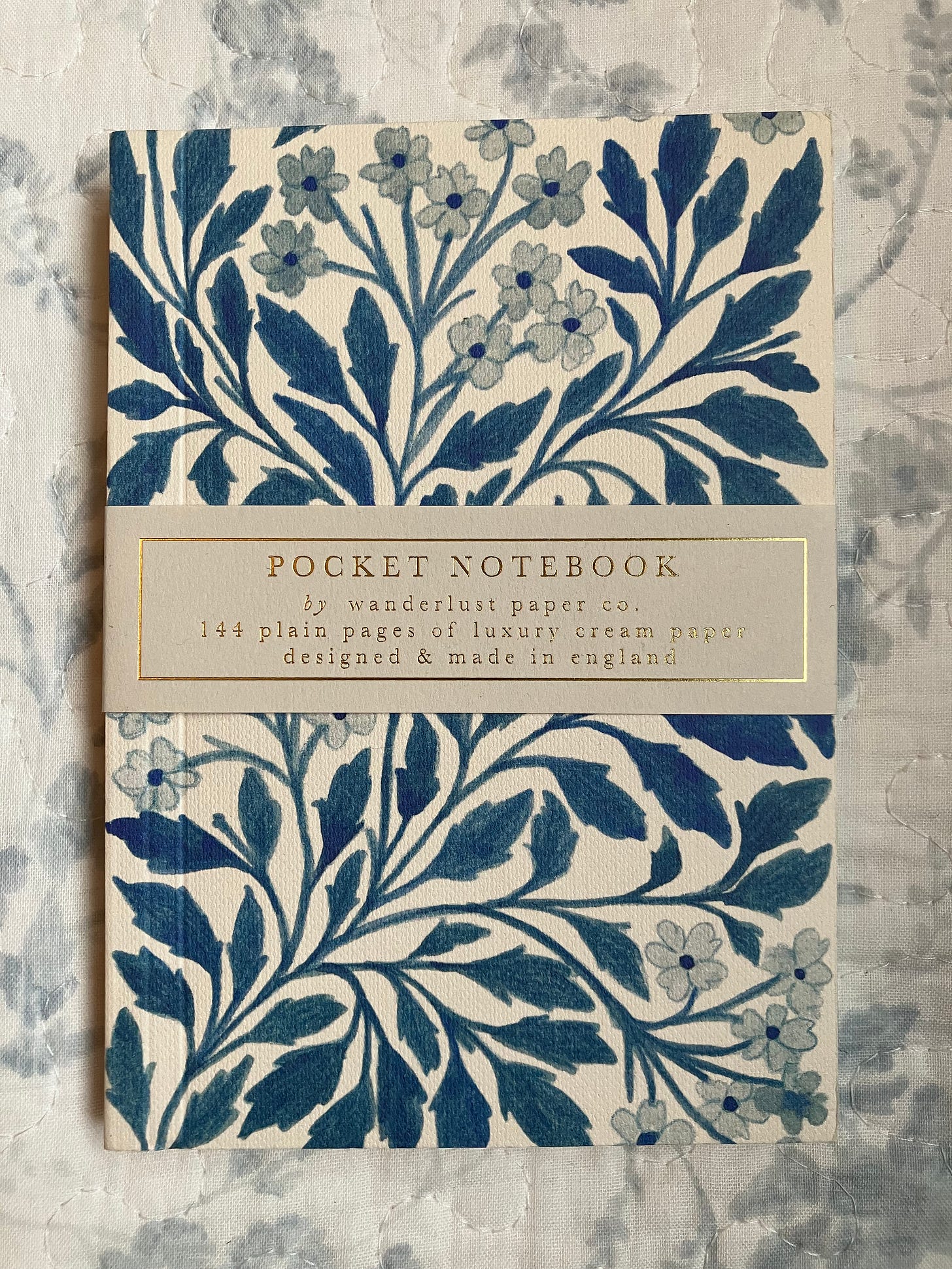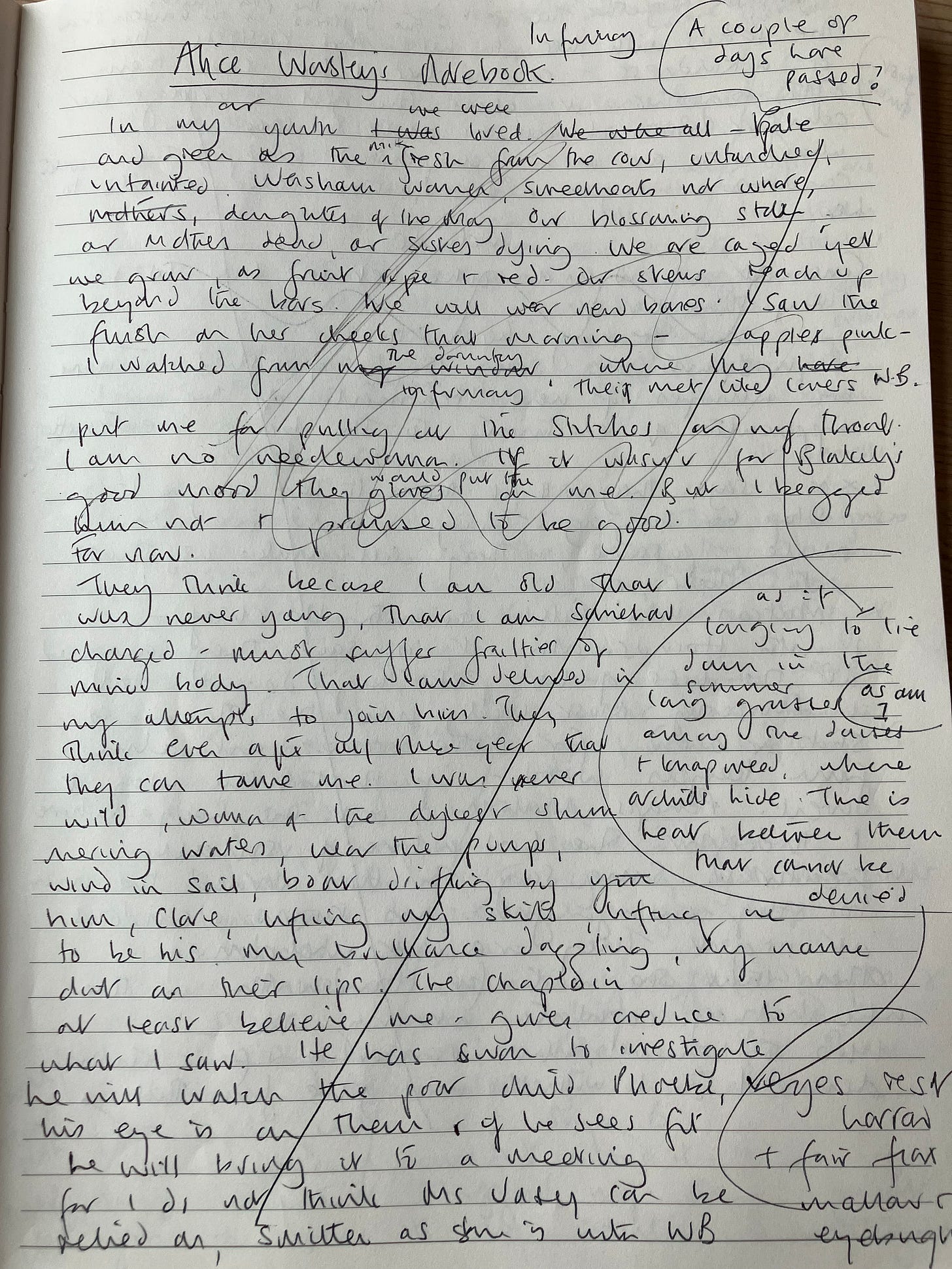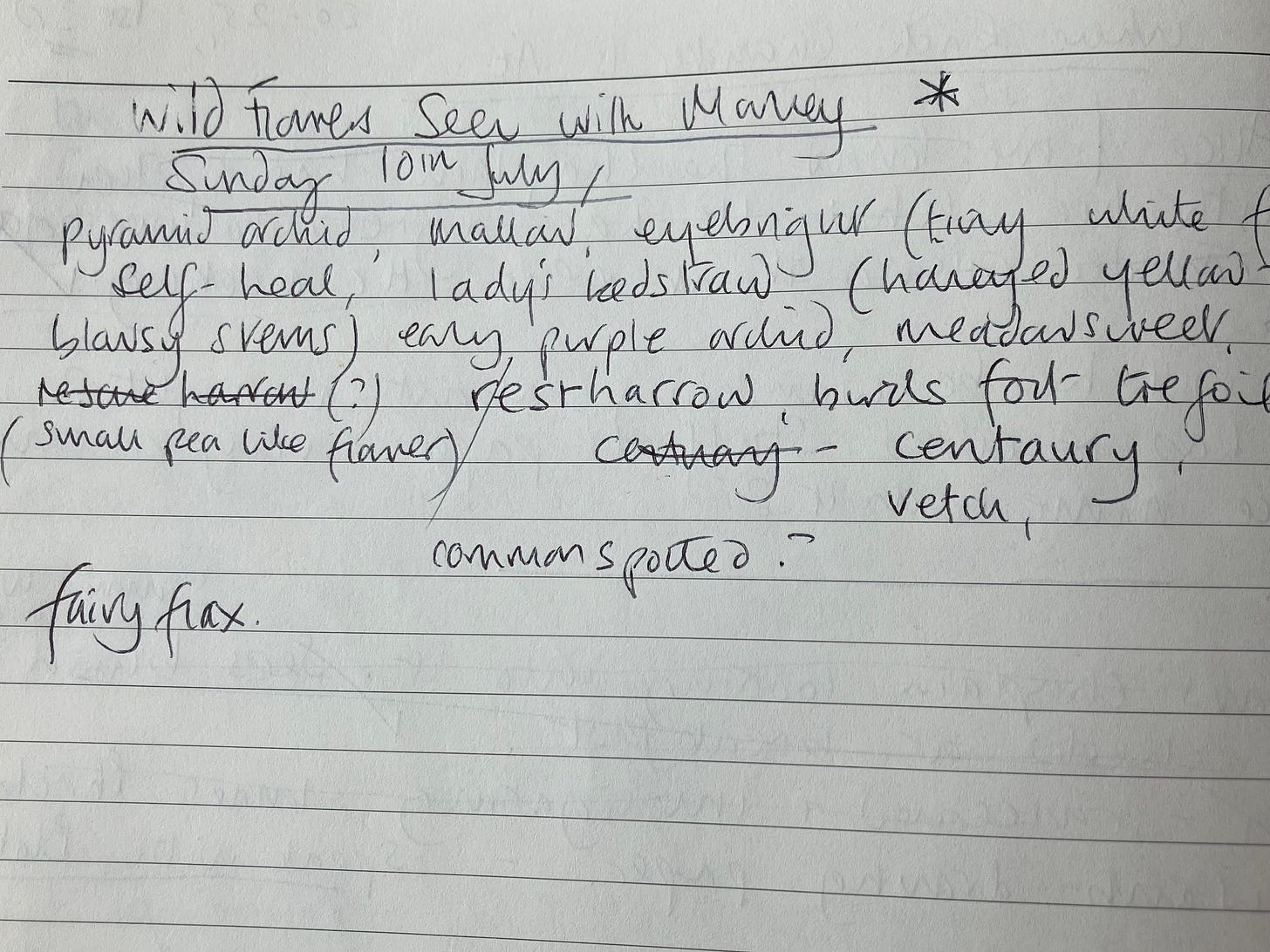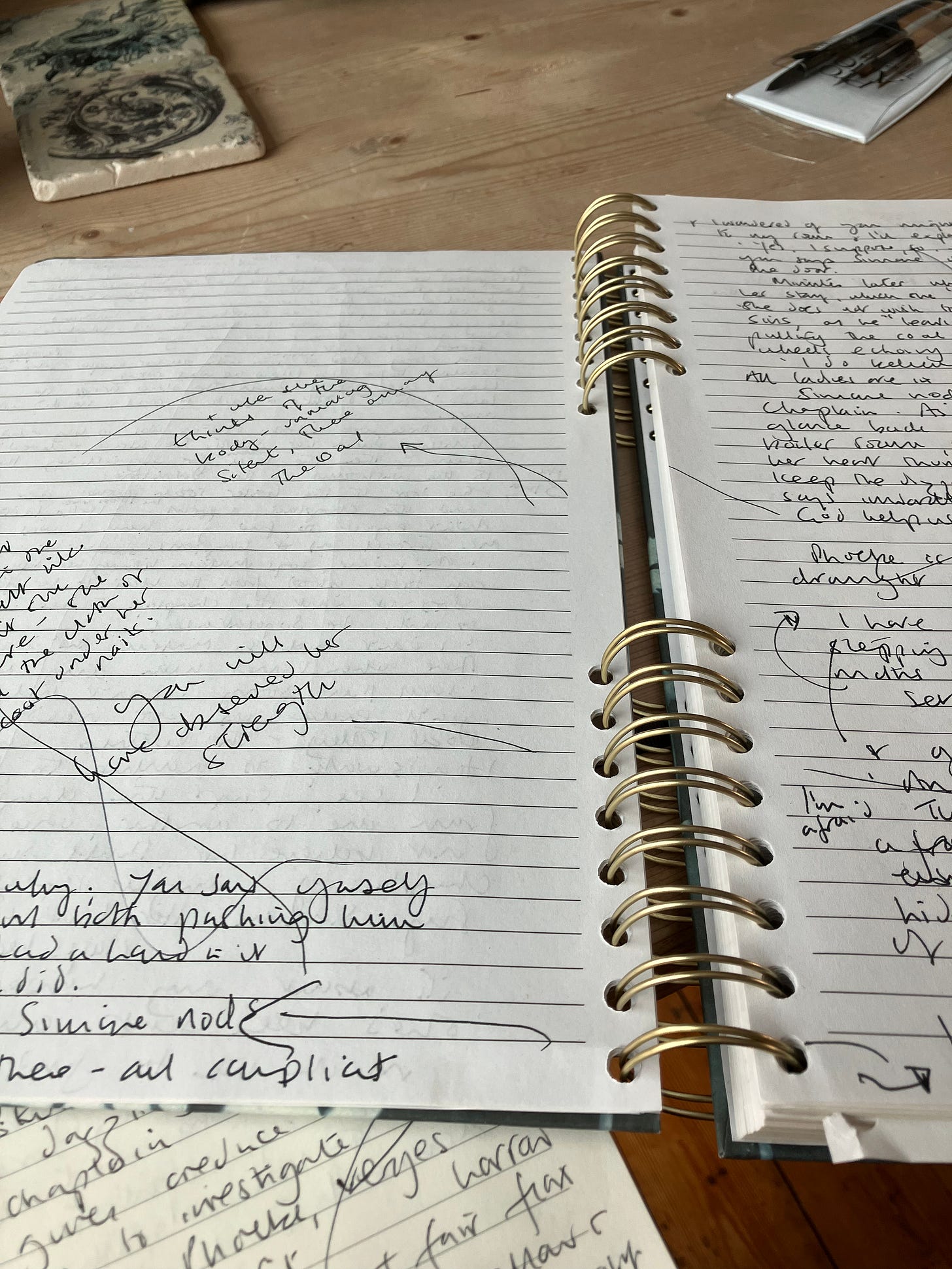This week's newsletter comes from my kitchen/dining room table where I’m writing alongside my daughter who is busy working on a unique commission for wedding stationery. It’s rare for us to get together in this way but it always feels like a privilege to share this long, scrubbed-topped table, that has seen so many gatherings of family and friends. It reminds me too of the hours spent here in one creative endeavour or another alongside my daughter and also my son, (both having built their own businesses, in part from this table).
There is nothing like the silent energy that comes from working in harmony with others - the clink of brush against glass, the tap-tap on the china palette - the hum of the radiators, though often, to be honest, it’s more like an annoying hiss, and the sun falling through the glass doors, patterning my notebook.
My daughter’s work is meticulous and exquisite, (take a look and see) as is her taste in notebooks. Every Christmas I can rely on her to buy me new notebooks, sometimes so beautiful it’s hard to imagine writing in them. Can a notebook be too beautiful I hear you ask? For me, yes, though I’m doing my best to overcome the idea. I usually reserve 'beautiful notebooks,' for lists, inspiring quotes, inspirations, jottings, first lines - they are rarely my workhorse.
When I’m writing long, a novel or a collection of stories or poems, I need a turbo-charged, heavyweight, A4 notebook, the kind I source in the supermarket. I need a big page. The larger the page, the freer I feel to scrawl. My first drafts often border on the illegible. I’m messy and I like to write quickly, without stopping to think, with a minimum of editing. That comes later. I often write on the right-hand page of the notebook and leave the left blank, using it to write notes to myself or adding things I’ve omitted.
A few years ago, when I was running a series of writing workshops at my local library, I took a photocopied page from my drafting notebook and showed it to the group alongside the same page from the published book. We looked at the changes which were significant and many of which were down to choices that I made in the editing process, often as small as a simple reordering of the words in a sentence.
Afterwards several writers told me how liberating they found it to see that first draft. It helped them to realise the words on the page did not need to be perfect, they were not, ‘it,’ merely the raw material. Looking inside my notebook gave those writers permission to write freely, badly even. Dani Shapiro advises the idea of telling yourself you're writing a 'bad book,' - hence no pressure - just the permission we need to get on with it!
Here’s a right-hand page from my, A Little Madness in the Spring, Notebook
You will see at the top right I’m asking myself a question about time - have a few days passed? If so it will be my job to signal this. Time is important, our job as writers is to move readers through time and place effortlessly, so that they know where they are and what time has passed without really noticing it.
Alice Worsley - becomes Alice Semple in the final draft. Names often change as characters grow. Alice cannot speak and we hear her voice through her notebook. She is one of three female characters in the novel, each of whom find themselves incarcerated in Long Meadow Lunatic Asylum in 1875. She is a Simpler, a herbalist and wise woman, once lover of the poet John Clare.
I’ve created two bubbles, I sometimes do this, when I’m thinking of something more to include - so I hastily make some space on the page (or alternatively use the left hand page.) In the first of the bubbles I note that I want Alice to tell us more about something she witnessed. In the second I reference the wild flowers I want to include later.
Here is the left-hand page - where those very flowers are noted (imports from another notebook) after a walk with my dear friend Marney - an expert in the matter of flowers.
Here is the final manuscript text (as yet unpublished) from two thirds of the way down the page - changes, plus additions - it will have been edited numerous times on the screen…
‘They wish to tame me. But I am ever wild, woman of dykes and shimmering waters, Clare lifting my skirts to the drum of the pumps, to the sails in the wind. My name on his lips. How I healed his wounds with lavender, fed him the flowers of St. John's Wort to ease his suffering. Men of science would do well to know the Doctrine of Signatures. Bring me walnut and carrot, eyebright, hyssop, feverfew and lemon balm, gather them under the planets as I did with Clare, when we wandered among rushes and thistles, on sheep tracks, along the heath in the golden blossomed furze. The fields were our church. Without him I am dust and I will join him soon but only when my work is done.
The Chaplain believes me for we have prayed on it. His eye is on them and he will bring it to the meeting. Miss Vaisey is smitten and cannot be relied on. He will investigate.’
Below - this is how messy it gets…arrows everywhere. For me this is the most creative way to get that first draft down on the page. I recommend it. I rarely if ever go straight to my laptop to write.
Next week Tabula Rasa - a poetry anthology plus a longer extract from, A Little Madness in the Spring.
If you're really struggling to find the time you need to write, Creativity from Chaos from Alice Murphy-Pyle is a great read, where she outlines a very helpful and interesting strategy for getting work done.
For more on the choices a writer faces and how it’s the essence of editing read - my piece on George Saunders’s wonderful book on writing, A Swim in the Pond in the Rain.
Thanks for reading, see you next week - Avril x







Wonderful! Posh notebooks give me an inferiority complex, moleskine or leather bound- a panic attack! Thank you for sharing your dirty laundry, my notebooks look just the same. I love the listed flower names. It's very brave of you, my writerly gussets are usually well steeped in editorial bleach before shown to all! Hyssop's mentioned-erm . . . it's not pretty, maybe I'll share another time!